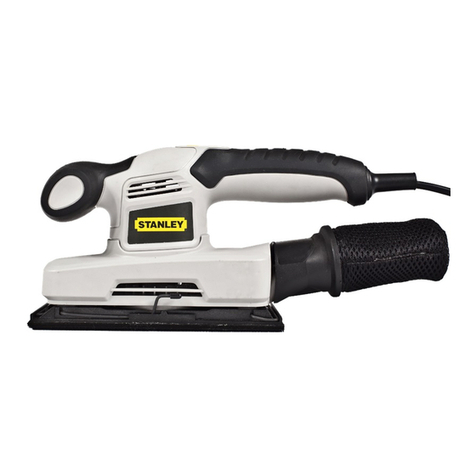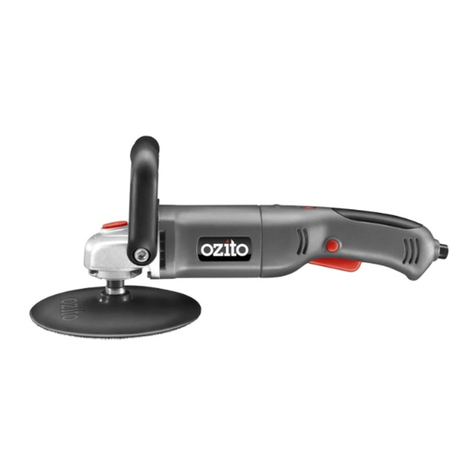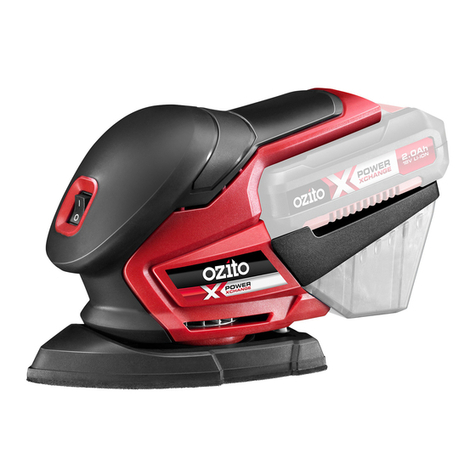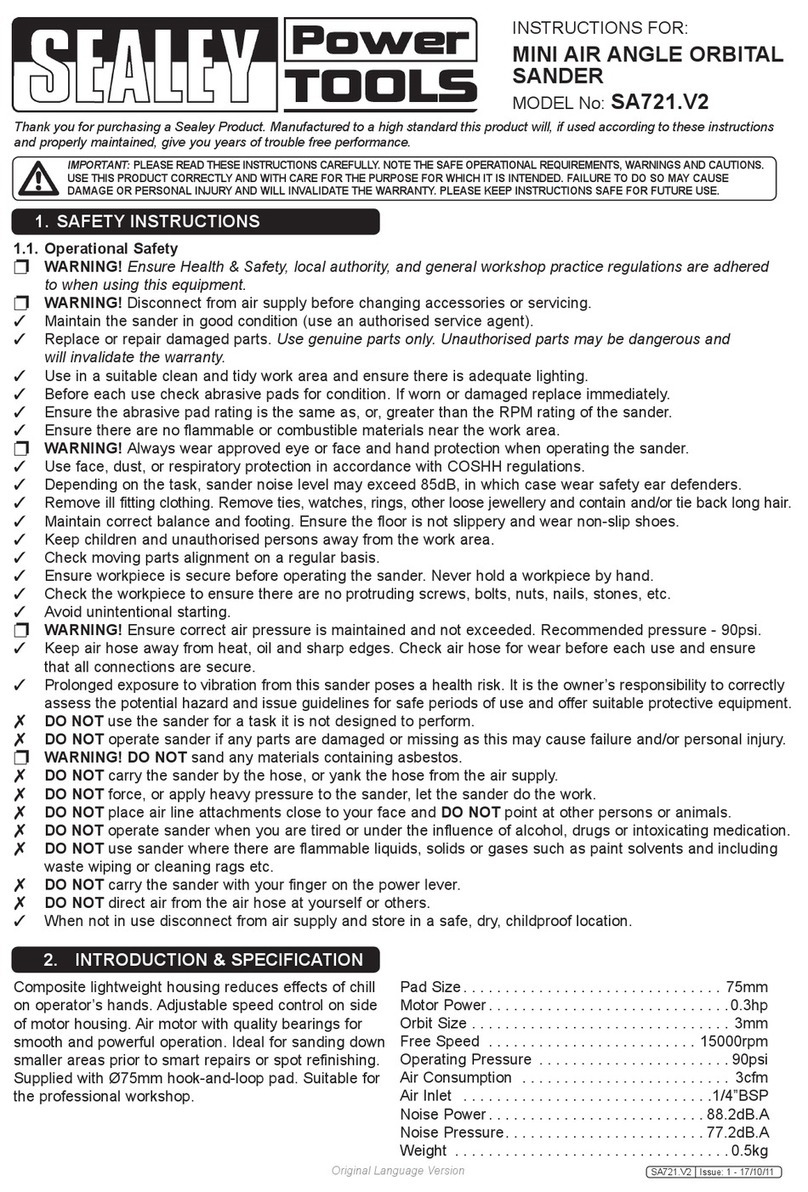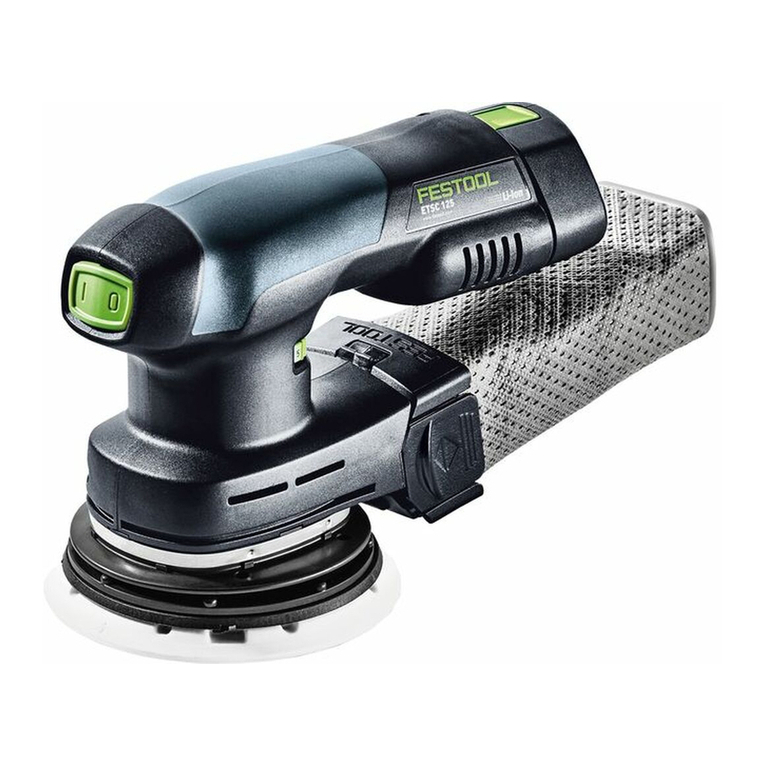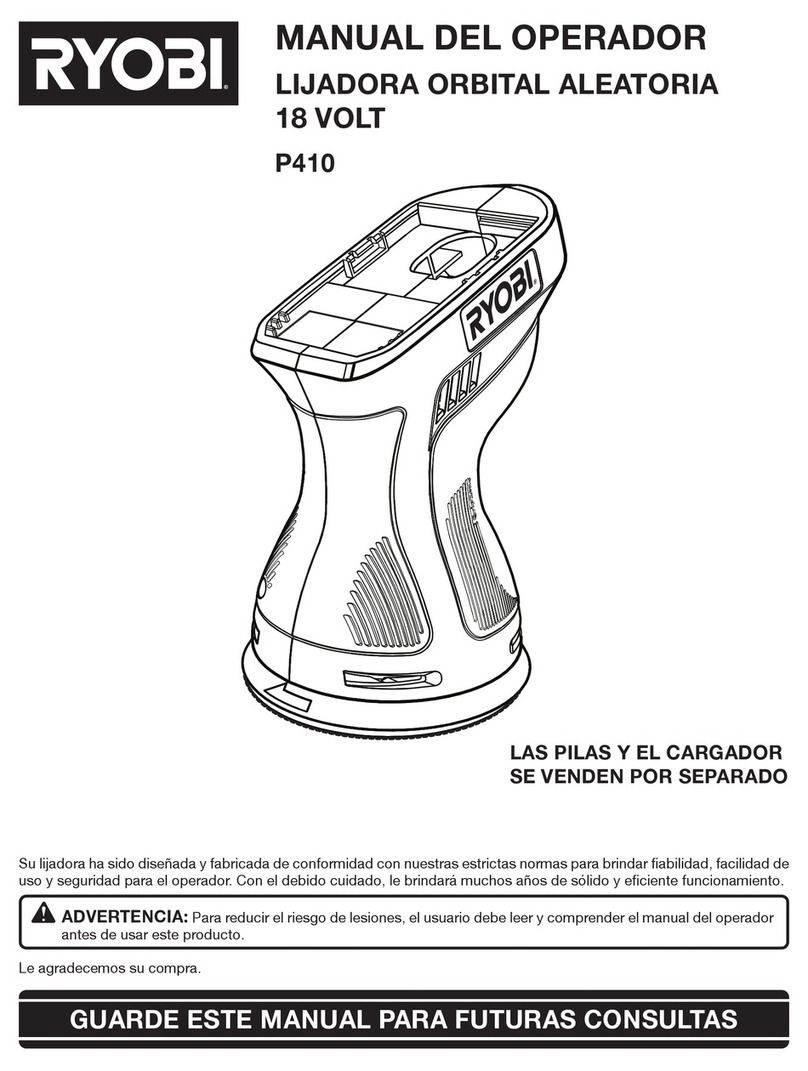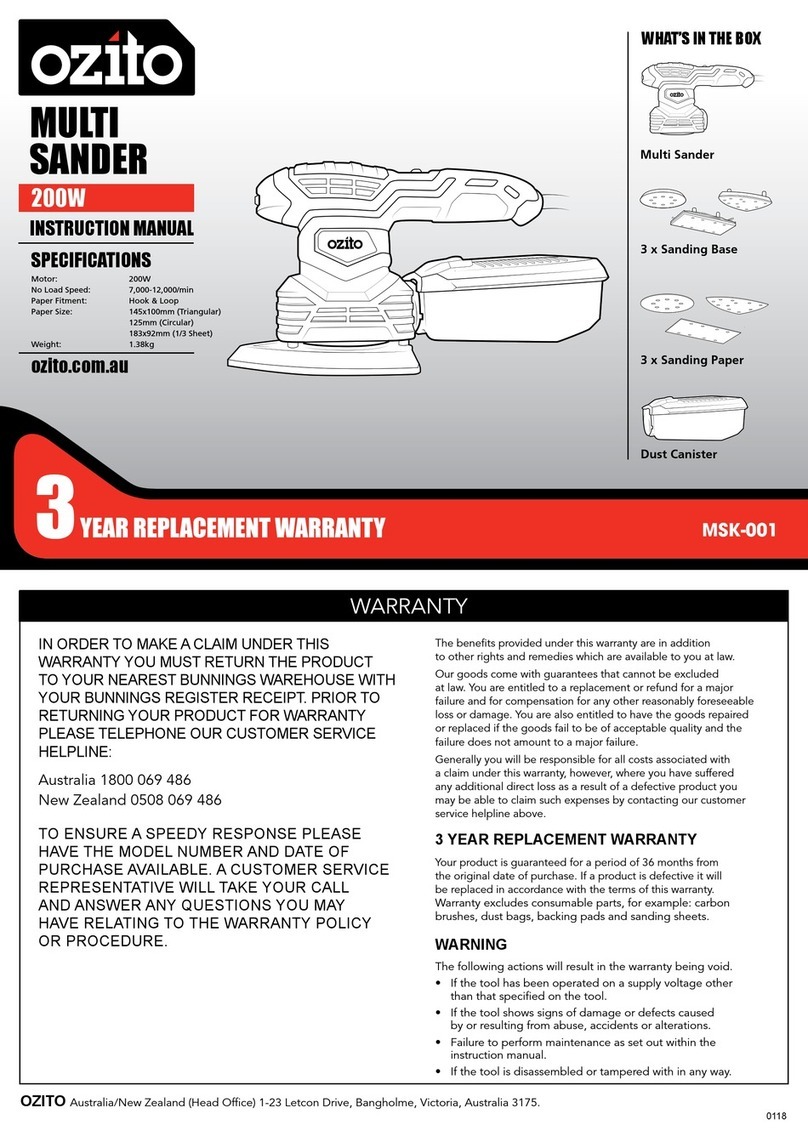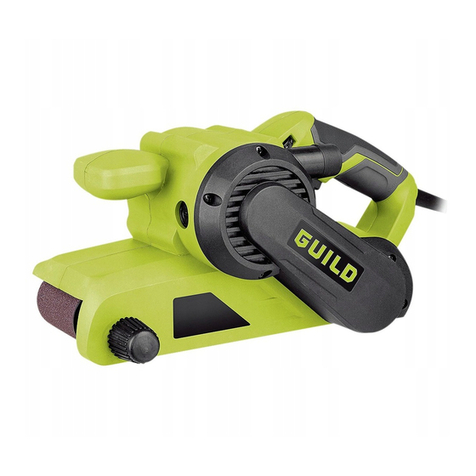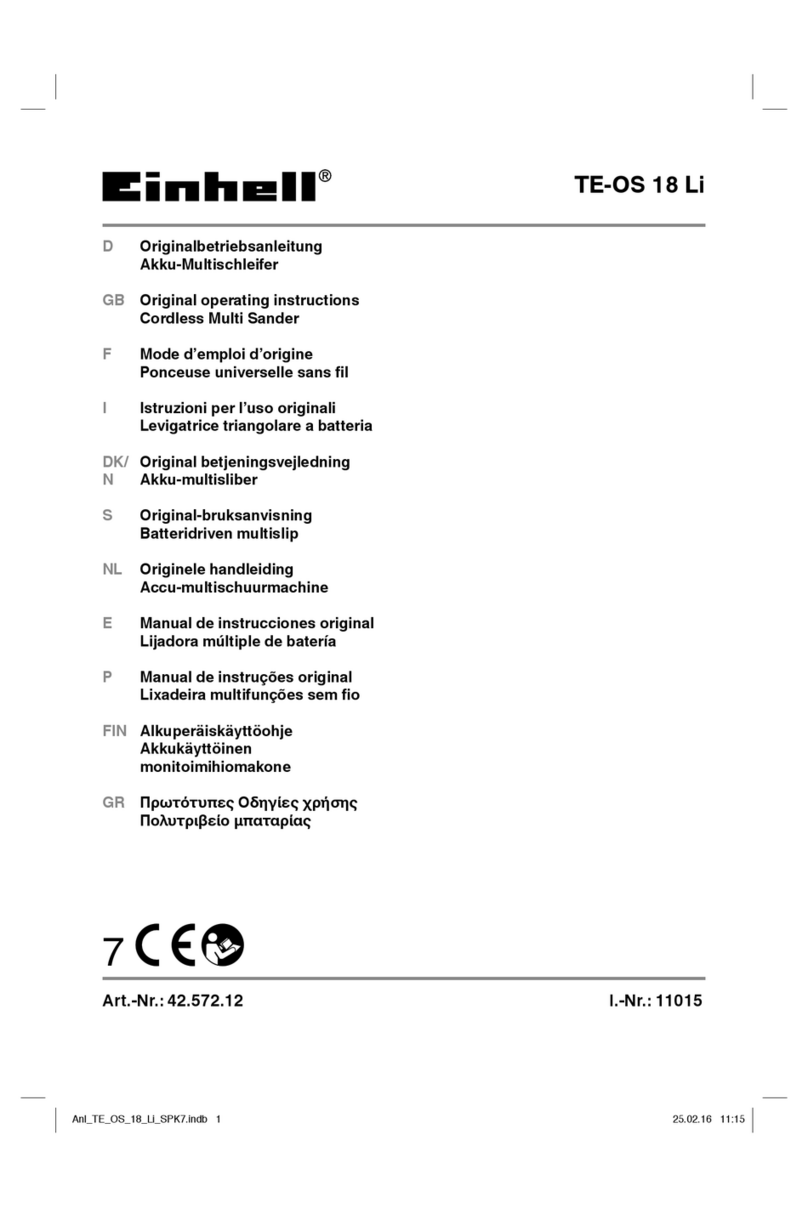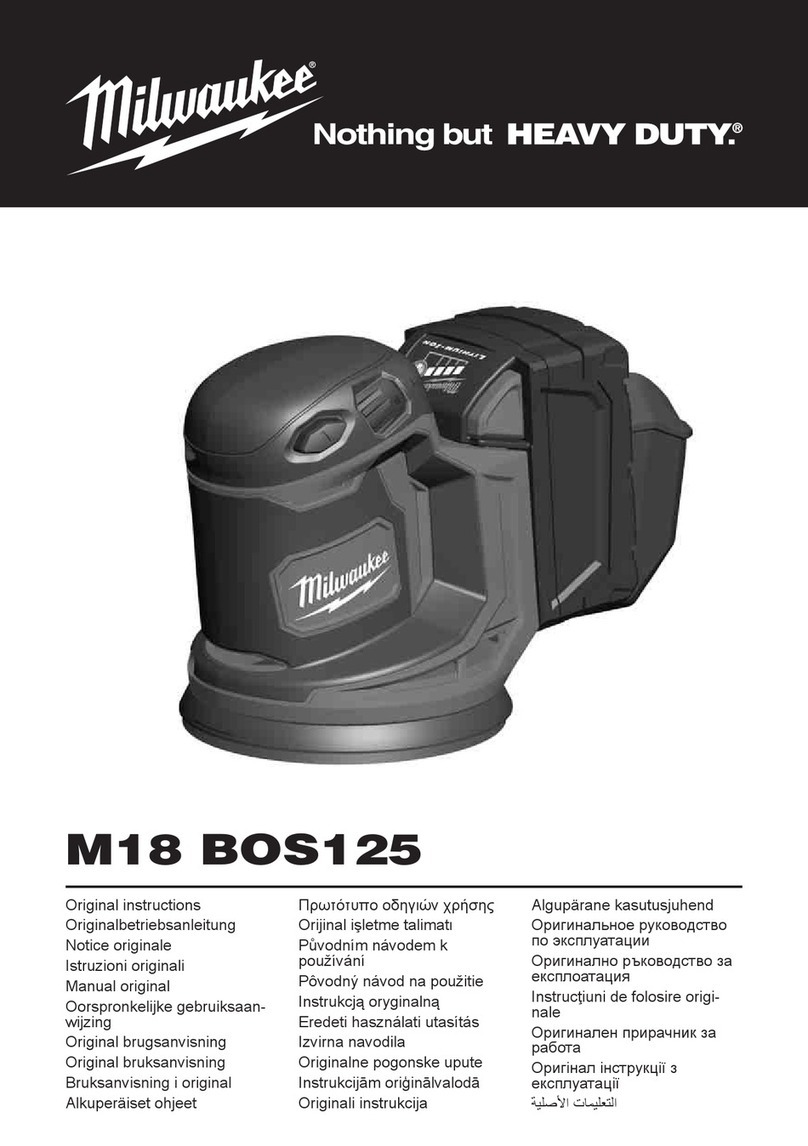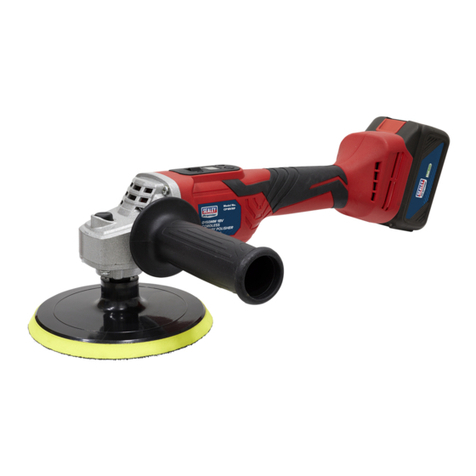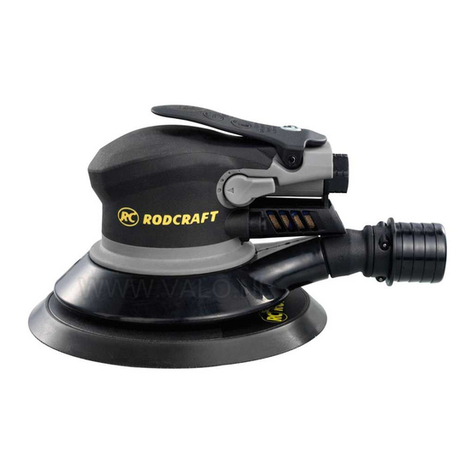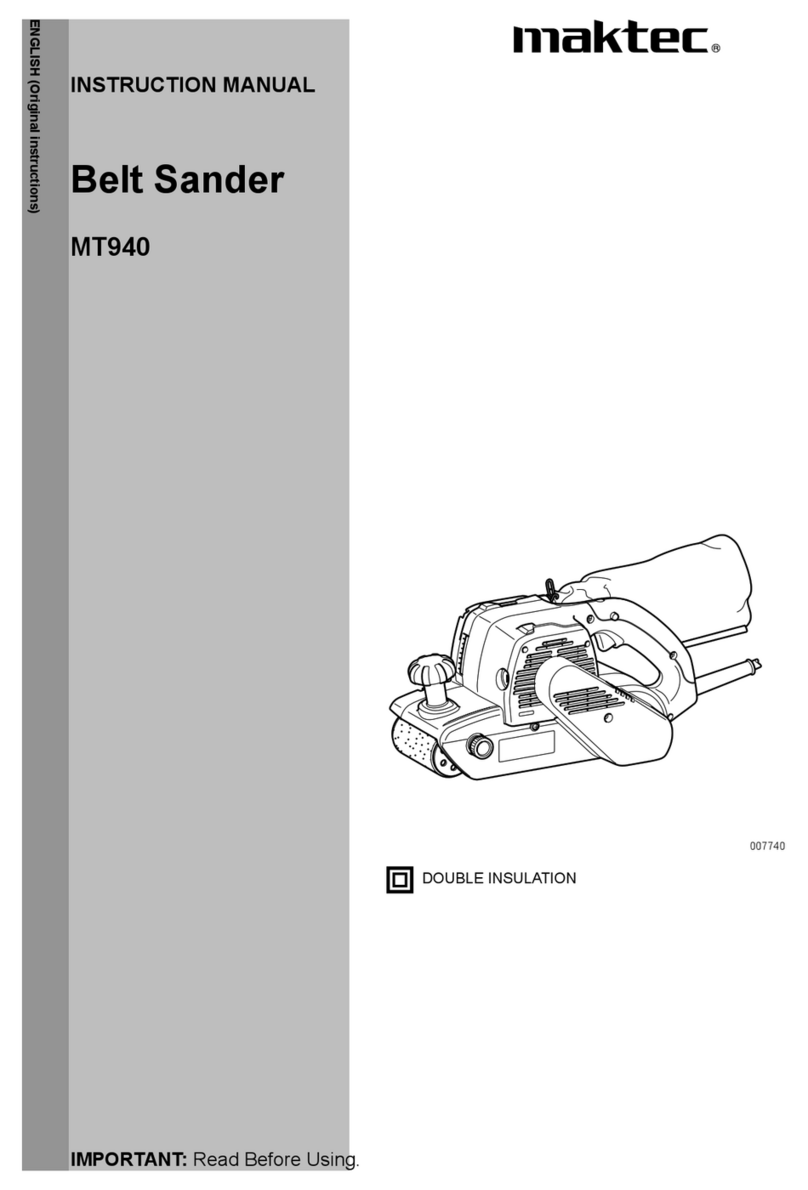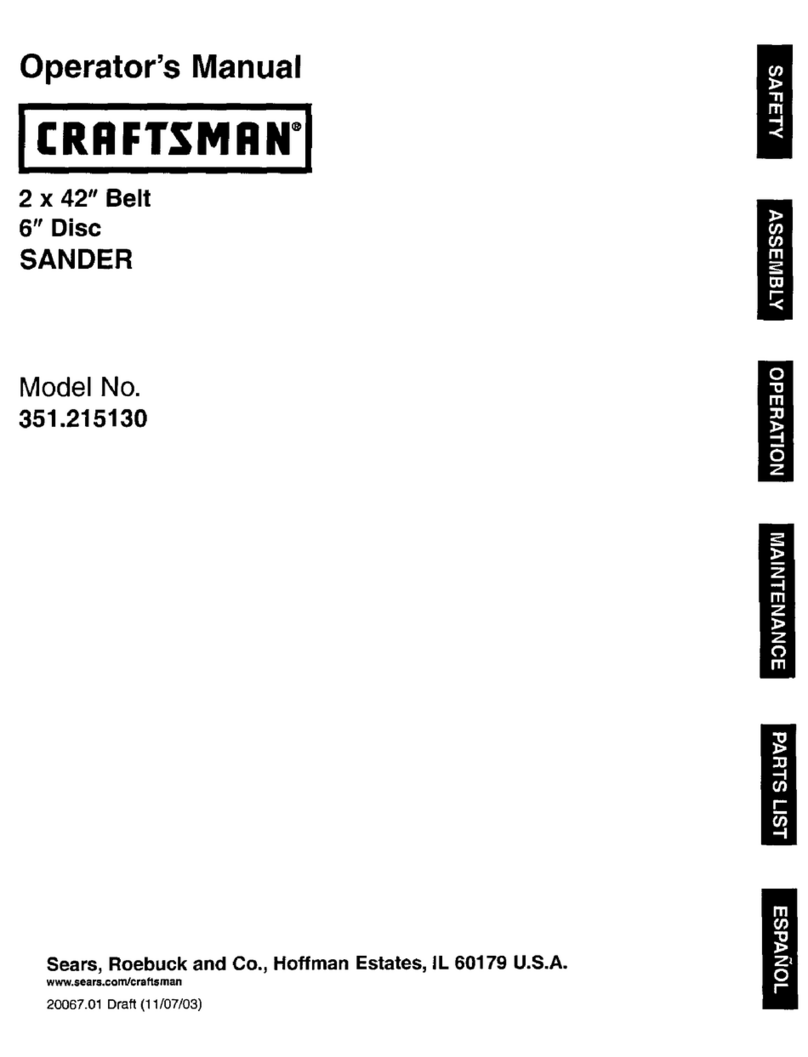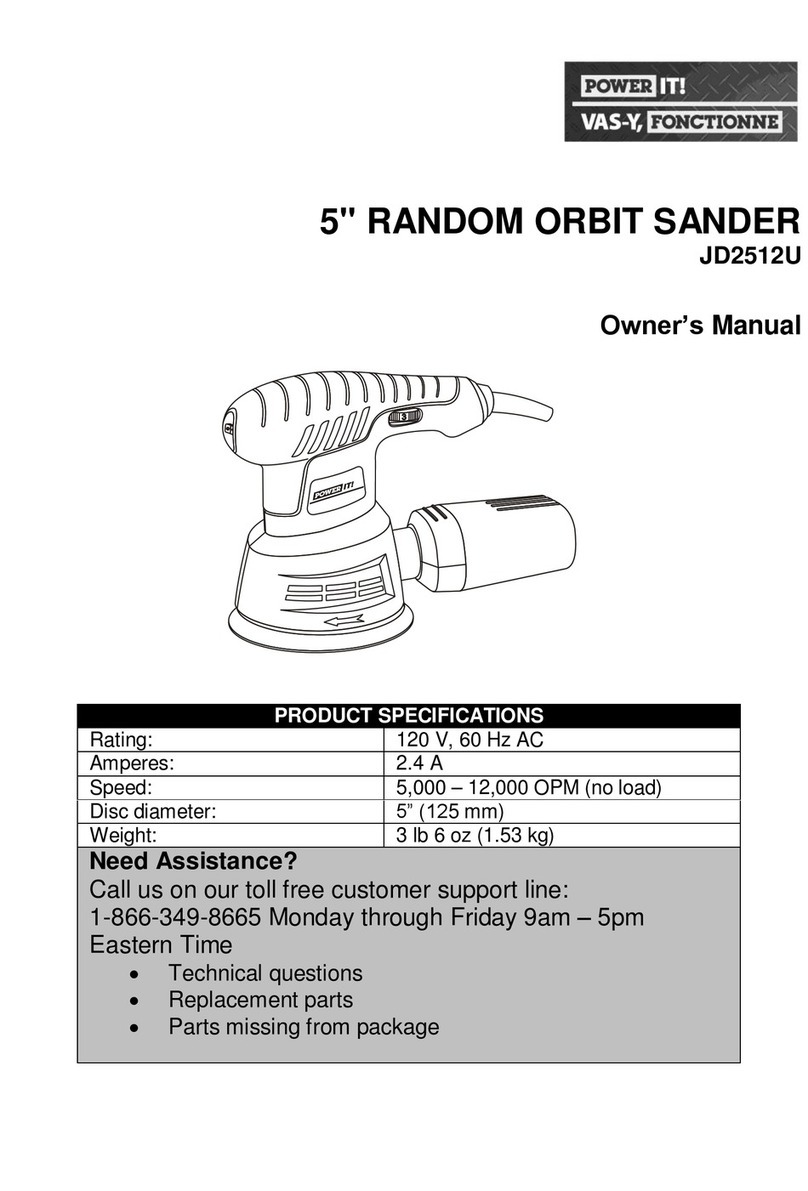DEVA HANDY-8E Installation instructions

HAN. DYTSE Floor Sander
. lnstructions for operation, maintenance
and safety.
. Assembly drawing and spare parts list.

lntroduction and technical specification
Safety lnstructions
lmportant parts of the machine
How to assemble the machine
Dust suction tube and bag
Setting up the machine
Leveling the machine
Sandpaper installation
Sanding drum pressure ...............
Starting the motor
I nstructions for e lectrical connection
How to operate the machine ................
Maintenance
4
5-6
7 -8
10
11
11
12
13
14
Changing and adjusting the
Sanding drum maintenance
Maintenance of the wheels
15
15
15
Prevention maintenance................ 15
Assembly drawing and spare parts list 18 - 21
Declaration of conformity .............. 22
Read this manual prior to operating this machine and keep it to hand for reading by
other personnel.
Si el usuario no puede leer el ingl6s, se le debe explicar el contenido de este manual
antes de utilizar la m6quina.
The manual contains important information for the use of this machine and safety
instructions for preventing personal ihjuries, damage to the machine or to other pro-
perty. ,l*i=" write to: :
For new books, please write to:
QUIDE S.A. ' .
P.O. Box 29
2A820 DEBA(Guiprizcoa) - SPAIN

This manual aims to help you use and take good care over
the years of this machine manufactured by QUIDE S'A for
which we offer you our warranty as manufacturers as well
as our technical assistance service.
Always keep this manual to hand Many of the instructions
and recommendations will be familiar and well-known to
you.
Should this not be the case, apply these instructions and
recommendations correctly and you will obtain excellent
results, safetY and satisfaction
It is important to remember that readlng this manual care-
fully can help you to prolong the life of your machine as it
will ensure its correct use.
lnspect your machine on receipt, make sure that it has not
been damaged during the transport. Check the contents of
the box to ensure that not accesories are missing
As always, we thank you for placing your confidence in a
DEVA product.
DEVA USA, lnc.
Single-phase AC motor
Motor power
Sanding drum" '
...
Drum r.P.m. ,,'' , "'
Suction fan sPeed
Machine weight
Gross weight
22o24OY150 Hz
2 HP.
200 mm.
2 300 r.P.m- "
6 800 r.p.m.
60 kg (133 lbs)
70 kg (155 lbs)

To::,redu.ce the,,,risk of fire, eleGtric shock and pe&nal :ihjury when
usihg:,,electical:,:tools, the following basic safety pre:cautio'nS,,should
always, be'takeh';,,,. ,,::,i ",,::,,
.You must have been trained to operate this machine
before using it.
. Machines can cause flammable materials and vapors
to burn. Do not use the machine with or near sol-
vents, thinners, fuels, or other flammable materials.
. To prevent the risk of fire or explosion:
a) Keep the machine away from sources of ignition,
as they could create an explosion during use.
b) Keep the work area well ventilated. Poorly ventila-
ted work areas can create an explosive atmosp-
here when they contain solvents, alcohol, thinners,
certain finishes or any kind of combustible mate-
rial.
c) Never leave a full dust bag in the machine.
Remove the dust bag when you have finished your
work.
d) Empty the dust bag when it is 1/3 full.
e) Always empty the sanding dust into a metal contai-
ner. This container must be outside the building.
f) Do not put the contents of the dust bag into a fire
or furnace.
g) Use a hammer and punch to set allthe nails flush
against the floor so that the sanding drum will not
touch them and create sparks which might cause
a fire in the dust bag.
Read these instructions carefully before operating or attempting to
carry out any service or maintenance procedure on this product.-
. Do not use the machine if it is not completely assem-
bled.
. To prevent electric shocks and personal injury,
always disconnect the power supply before chan-
ging the sandpaper, emptying the dust bag, leaving
it unattended or attempting any maintenance or ser-
vice of the machine.
. To prevent electric shocks, avoid contact with groun-
ded surfaces, i.e. pipes, radiators, refrigerators, etc.
. Do not expose the machine to rain. Keep the electri-
cal parts dry.
. The machine should be stored in a dry place and out
of the reach of children.
. Check the cable and plugs and replace them if
damaged. Do not use the machine if the cable is
damaged. Keep the cable away from heat, oil, water
and sharp edges.
. Always connect the machine to a grounded power
supply. Never disconnect the ground cable from the
machine.
. Always use a cable with 3 x 1,5 mm of section and
connect the machine to a grounded plug. Ensure
that the plug really does have a ground connection.
. Make sure that the power switch is in the "O" posi-
tion before connecting the cable to the electrical
power supply.

. Keep the cable away from the underside of the
machine to avoid contact with the sandpaper as this
could cause electrocution. Always keep the cable on
top of the machine.
. Moving parts can cause injury and/or damage. Keep
hands, feet and loose clothing away from all the
moving parts of the machine.
. Make sure that all guards, doors and covers are
secure and in place before starting to sand.
. Check that all warning labels are legible and duly
stuck on to the machine. Should any of them become
damaged or illegible, replace them immediately. Ask
the authorized distributor for new labels.
. Make sure that the person who is going to use the
machine has read this manual beforehand.
. Do not use this machine as a step or furniture.
. Do not use this machine for moving other objects or
people.
. This machine is heavy. Separate the suction tube if
you are going to transport it single-handed. Trying to
lift this machine single-handed could cause serious
back injuries. Always get help to lift the complete
machine.
. Be careful not to accidentally start the machine,
make sure that your hands are empty when you turn
the switch.
Shodk
basiC
. Always use a face or dust mask if the sanding ope-
ration is dusty.
. Stay alert. Watch what you are doing. Use common
sense. Do not operate the machine when you are
tired. Keep proper footing and balance at all times.
Wear ear protection when using the machine for long
periods. Hold the machine tightly with two hands
when working.
. Always disconnect the machine when not in use,
before servicing and when changing accessories.
. Never carry the machine by its cable or wrench it out
of the socket.
. Always keep children away from the machine.
Visitors should be kept away from the work area.
. Using accessories or attachments other than those
recommended in this instruction manual could cause
personal injury.
. Check the machine for damaged parts before use.
Check the alignment and binding of moving parts,
breakage, mounting and anything else that may
affect its correct operation.
. Do not use the machine if the on-off switch does not
work correctly. Defective switches must be replaced
by an authorized servicing center.

Fig. 1
This sander has a cable holderthat could be moved
to the right or left side of the machine. (Fig. 1).
The machine is designed to work with three different
types of drums:
EXPANDIBLE DRUM (Fig. 2)
BAR GLAMP DRUM (Fig. 3)
CONVENTIONAL DRUM (Fig. 4)
Fig.2
Fig. 3
Fig. 4

The machine has a single-phase havy-duty AC motor'
free of maintenance.
Power supply: 220-240V150 Hz only (Fig' 5)'
The suctron dust tube is placed at the back of the
macfrine next to the handle and lever for controlling the
sanding drum (Fig. 6).
The dust bag must be fastened in place before using
the machine as in (Fig. 7).
The machine has one Poly-V belt for turning the drum
and the suction fan.
The drive belt is adjusted with belt slack adjuster'
(Fis. 8).
Fig. 5
Fig.7
Fig. 6

To fit and adjust the dust suction tube and bag, proceed as
follows
O frt tfre dust suction tube in place (Fig. 9).
€) Adjust the screw holding the tube. (Fig 10)
O Attach the drum control lever (Fig. 11 and 12).
O Ctip the dust bag tightly to the dust suction tube

How do we level the machine?
Tilt the machine as in (Fig. 13 and 14).
The machine is provided with an adjustable system in
orderto levelthe machine when requiered. (Fig. '15).
Loosen the leveling screw to sand heavier on drive
belt side of the sanding drum.
Tighten the leveling screw to sand heavier on the side
opposite the drive belt. (Fig. 16).
Fig. 15
14
Fig
,*-
t'-: J
&
F
Fig. 13
Fig. 16
10

Fig. 17
To install and adjust the sandpaper, proceed as
follows:
EXPANDIBLE DRUM:
This type of drum uses unless sandpaper which
you slide onto the drum. When the drum spins, the
rubber expands and firmly holds the sanding belt
(Fig. 18a,b)
BAR CLAMP DRUM:
Easy access to the drum allows quick change of the
sanpaper which is held on the drum by a metal bar
with screws (Fig. 18c,b)
CONVENTIONAL DRUM:
Cut out the sandpaper to the same size as the pat-
ter provided with the machine.
Raise the lid covering the drum (Fig. 18).
lnsert one side of the sandpaper into the slot on the
drum, turn the drum around until it is covered with
sandpaper and insert the other extreme into the
same slot (Fig. 19a,b)
Use both keys to adjust the sandpaper against the
drum by turning one key fonryard and the other
backward, as in (Fig. 19c)
Make sure that the sandpaper has been correctly
inserted.
The machine has
controled by spring only one sanding drum pressure
. (Fig. 20).
11
Fig. 1a
Fig. 19
Fig. 2O

Wffi;\r-il g c g : l A I e i" lll jt a jl, I 'i ffi "'ffi]]]llllllll
To operate the machine follow this procedure:
O Connect the handle pigtail to the motor cord.
(Fig. 21,22)
f) Connect the machine to the electrical power.
@ tfre machine has a double-bladed knife safe switch with
under voltage release. The "1" position is used to start
the motor and the "0" position to stop the motor.
(Fis 23).
Fig.21
Fig.22
Fig. 23
12

This machine must only be connected to an AC frequency at the electrical voltage shown
on the motor plate (220-24AVl5O Hz, single-phase)
. To prevent electric shock keep the machine in a dry place.
. Do not expose the machine to rain.
. The machine cable and connection plugs must be in per-
fect condition.
. Unplug the machine after use.
. The machine must be connected to a grounded electrical
circuit in order to protect the operator from electric
shocks.
. Make sure that you are connecting the machine to 220-
240V.
. When connectingto 22O-240V make sure that the electri-
cal circuit in the house or building is grounded.
. Do not cut, remove or break the ground pin.
. Do not use a machine with a damaged plug or cable.
. Do not use the machine if the on-off switch doesn't work
correctly.
. Avoid reductions in voltage, use 3 x 1,5 mm of section
cables measuring no longer than 30 metres.
13

After starting the motor,
behind the machine and
hands (Fig. 25).
operator must stand
it in place with both
the
hold
Move the machine fonrvard slowly and push down the
drum control lever (Fig. 26).
Move the machine slowly and constantly.
Before reaching the end of the circuit marked out by
the machine, lift the drum gently (Fig.27).
Pull the machine back over the mark it left when it star-
ted moving, lowering the drum gently when you start
the backward movement.
Keep the sander in motion while the drum is working
or marks will appear which are very difficult to remove
with further sanding.
Always work from left to right.
ln order to obtain satisfactory sanding, the sandg.r
should be passed over the surface several times with
different sizes of sanding grain.
We recommend that the sander be passed over the
surface at least three times if the floor is new. lf the
floor in question has already been varnished we
recommend that the sander be passed four times,
according to the following chart:
Passes New floors Old floors
first grit 30 - 36 grit 24
second grit 60 grit 36 - 40
third grit 100 grit 60
fourth grit 100
Fig. 25
Fig.26
Fig.27
14

Fig. 28
It is important to check the tension of the poly - V belt
and change it if necessary. Loosen the screw to adjust
or change the belt and then tighten it.
The belt must neither too tight nor too loose.
Remember that over-tight belt make it difficult to start
the motor and that the drum will turn freely if they are
too loose (Fig. 28).
Check that the drum surface is in good condition and
that there is no sawdust inside it, as this could throw it
off balance (Fig. 29).
Clean the sanding drum from time to time, using air to
clean out the drum chamber.
Check the wheels periodicatty (Fig. 30).
. Make sure that the surfaces do not have glue or
debris stuck to them.
. Change them when worn.
. Clean the bearings with air.
ln order to avoid inconvenient setbacks, we suggest
that you carry the following along with your normal
tools:
.aPoly-Vbelt.
. a dust bag.
. a set of capacitors.
ln this way you will be sure that your machine will
always function (Fig. 31).
Fig. 29
Fig. 3()
Fig. 31
l3

. Below we offer a series of suggestions which will
enable you to resolve some of the most frequent
problems which arise when sanding wooden flo-
ors.
. Sometimes the belt make a noise as if it is slip-
ping. This means that it is not fitted tighfly enough
or that it is worn and need changing.
. The ball bearings are protected against dust and
are self-lubricating. However, they have a limited
life span depending on the amount of time the
machine is in use.
Chances are that the machine will have sucked in
a nail, a piece of wood or any other foreign body
which will have blocked the blades of the fan.
To solve this problem, try to turn the blades
manually and remove the foreign body that is blo-
king it.
. Firstly, clean the floor to make sure that there are
no nails lying around.
. Brush the floor before sanding to avoid remains
of materials which could damage the rubber
drum.
. By way of indication, their useable life is approxi-
mately: . Take care not to insert sandpaper which is too
long, as this will cause it to fold and leave marks
on the floor. lt could also cause the sandpaper to
break while working.
. lf the motor functions haltingly once it has been
switched on and set in motion, this means that:
a)The electric voltage is too low.
b)The cable is too long or the cross-section is
inappropriate.
c)The work capacitor is defective.
d)The motor is defective.
. lf the motor does not start, thrs means that:
a)The electric voltage is too low.
b)The starting capacitor is defective.
Fan shaft
Motor shaft
Drum shaft
2500 hrs of use.
5000 hrs of use.
5000 hrs of use.
. No matter what the case, if you hear a strange
noise, check whether it is coming from the drum,
motor or fan. Run the motor together with the
drum alone and then the motor with the suction
tube alone, which will make it easy to pinpoint the
noise. Once found, the faulty bearing has to be
changed.
. Should you notice that the fan is not turning, the
machine is not vacuuming, and that the fan belt
is making a slipping noise, STOP THE MOTOR.
to

c)There is no electricity in the plug.
d)The cable pins are not properly connected.
e)The motor is defective.
Should the demand limiter jump when the motor
is started, it means that the house has less than
15 amps. lf this happens, DO NOT INSIST ON
TRYING TO MAKE lT START, as you will only
succeed in burning the capacitor.
. lf you observe that the machine is sanding more
on one side than the other, it means that it is not
exactly levelled. See the section Leveling the
machine in this manual.
. These usually appear on the floor like a thread
after the last sanding (fine grain). This is becau-
se a tiny stone has left a mark on the sandpaper
which, in turn, is leaving a thread-like mark on
the floor. The solution is to change the sandpa-
per and clean the floor well before passing the
fine-grain sandpaper.
. Sawdust, glue or any kind of material which
sticks to the wheels can leave marks on the floor.
Always make sure that the wheels are comple-
tely clean before sanding.
. Excessively long pieces of sandpaper can crea-
te a fold on the drum and cause
marks. Avoid this anomaly by cutting
the piece of sandpaper to exactly the
same shape as the sample provided with the
machine.
. Any material leftovers which get stuck between
the drum and the sandpaper can also leave
marks on the floor. Always check the surface of
the drum to ensure that it is clean and in good
condition.
. When using the machine, try to maintain a uni-
form and constant sanding speed. Otherurise,
marks might appear on the floor.
. Lowering the drum too quickly will cause marks,
.-.==- which will be even more
obvious if you pass over them
€ again in the same direction.
-.::::::=:--.J
-:--: TL
stops" is by sanding the mark on the floor at 45o.
. Always carry a spare set of capacitor with you.
.lf the building has a voltage lower than 220-
240V, you might have problems starting the
motor. ln winter, with low temperatures, the belts
and interior of the bearings stiffen, meaning that
the motor might take longer to start.
DO NOT INSIST ON TRYING TO START THE
MOTOR. This will only cause the capacitor to
burn out.
17

2
64
1
2A
li
A=..t
HILT
HANDLE
SCREW DIN 915 tol 8 x 12
scREW DIN 913 lvl I x 8
SCREW DIN 9'12 M 10 x 60
12 GLYCODUR
13 BOLT
14 GLYCODUR
,I5 SPACER
16 UPPER ROD
16.1 SCRFW DIN 7991 M 5 x 12
17 LOCKING PIECE FOR RODS
17.1 LOCKING PIECE
18 LOWER ROD
20 SUCTION TUBE
21 DUST BAG
22 SWITCH EUROPA
22 SWITCH USA
23 SCREW DtN 912 M 5 X 12
24 SCREW DIN 963 lV 5 x 10
25 SWITCH BOX COVER
26 SWITCH BOX
27 STRAIN RELIEF PG 11 ESPIRAL
2A CABLE WITH PLUG
2A CABLE WITH PLUG USA
29 CABLEWITH PLUG (GROUNDED)
29 CABLE WITH PLUG USA
30 SCREW DIN 7991 M 6 x'16
31 MOTOR WASHER
32 FAN PULLEY o 40
32 FAN PULLEY o 30
33 FAN SHAFT
33 FAN SHAFT (')
33.1 FAN UNIT
U KEY4x4x18
35
35
37
38
38
38.1
40
42
43
44
(.)
KFY4x4x12
SPACER
BALLBEARING 6005 WCIVI
BEARING HOUSING (-)
BEARING HOUSING
AXIAL DISC INA AS3O47
V.RING JOINT V 30 A
SCRE!!'DlN912M6x20
SEEGER I 47
SEEGER E 25
VENTILATOR WHEEL (")
VENTILATOR WHEEL
WASHER
SCREW DIN 912 lvl 5 x'16
CONSULT THE VERSION
6
6.1
6.2
6.3
6.5
7
I
10
BRACKET
CABLE HOLDER
HOLDER BRACKET
COMPRESSION SPRING
SCREW DlN912MBx25
scREw DlN 7991 M 6 x16
BOLT
BALL KNOB o 30
LEVER
SEEGER E 8
18

z4*s4
(( g-"
57
zL-G- K/'
-qs
gf \: 63.3
\ ...,
63.5
.4
58
69 ./>
'^-+z/
<,/ ,/
r 65
A-,n,
w 783
'70
1).
73
'74
'75
55.2
'ta.r I {
\d\ '14 .2
'74.2
45 SCREW DIN 912 M 8 x 60
46 EXCENTER SHAFT
47 SEEGER I 47
48 BALLBEARING 6005 WCM
49 POLY V BELTS TENSIONER
50 SPACER
51 POLY V BELTS COVER
52 SCREW DlN912M5x16
53 SPACER
54 SCREW DIN 912 M 6 x 16
55 LIFT HANDLE
56 SCREW DlN912MBx16
57 HANOLE
58 SCREW DIN 933 M 10 x 55
59 SCREW DlN912M8x30
60 SCREW DIN 913 M 6 x 20
61 PIN DIN 7979 a 10 x 50
52 POLY V BELT 5J 965
63 HOUSING
63.1 SCREW DIN 931 M 8 x 35
63.2 CLAMP RING INA BRl9
63.3 BALLBEARING 626 2RS
63.4 CONSTRAINER
63.5 SPACER
64 COVER (DRUM U'l78mm)
64 COVER (DRUM d 'l50mm)
65 SCREW DIN 84 M 5 x 8
66 COVER
66.'l SCREW DIN 963 M 4 x 8
66.2 COVER PROTECTOR
67 BUMPER
68 SEEGER I 40
69 BALLBEARING 6203 2RS
70 REAR WHEEL SPACER
71 REAR WHEEL SHAFT
72 SCREW OIN 91 2 lvl 10 x 20
73 BALLBEARING AXK/AS 2035
74 REARWHEELBRACKET
74,1 REAR WHEEL COMPLETE
75 SCREW DtN 7991 M 10 x 70
76 SCREW DIN 913 M 8 X 8
77 SPACER
78 WHEEL O 80 COIVIPLETE
78.'l SCREW DIN 912 M 5 x 12
78.2 BALLBEARING 6202 KBC 2RS
78.3 WHEEL COVER
78,4 TIRE FOR WHEEL U 80
78,5 WHEEL HALF
79 SPACER
19

A.\-
'v;
r f 6
1!5
80
8't
82
83
84
85
87
88
89
90
9't
91
92
92
93
94
SPRING BRACKET
SPRING
NUT OIN 985 M 8
WASHER DIN 125 M 8
SCREW DIN 912 lvl 8 x 35
LIFTING FIXTURE
WASHER DIN ,I25 I\4 12 USA
NUT DIN 985 M ,12
GLYCODUR
GLYCODUR
COMPRESSION SPRING
SCREW DlN912MBx70
NUT DIN 985 lr1 I
WHEEL SHAFT
SPACER
NUT DIN 985 I\.1 10
WHEEL o 80 COMPLETE
95 WASHER DIN 125 M 1O
96 SCREW DIN 933 M l0 x 55
97 TENSIONER BRACKET
98 SCREW DIN 912 M 6 x 25
99 SCREW DIN 7991 M 6 x 16
1OO MOTOR WASHER
,10,1 DRUM PULLEY g 96
101 DRUM PULLEY A 93
102 SEEGER E 25
103 SEEGER I 47
104 BALLBEARING 6005 WCM
105 SCREW DIN 912 M 6 x 16
,I06 SHAFT BRACKET
107 KEY4x4x18
108 DRUM SHAFT
109 KEYBx7x50
110 SPACER
111 NUT
112 WASHER
113 COUNTER WEIGHT
114 SCREW DIN 913 t{ 5 x I
1,l5 SCREW DIN 913 [4 5 x 10
116 SCREW DIN 913 tYl 6 x 16
1I7 SANDING DRUM RUBBER
1'18 DRUTM 175
118.1 SANDING DRUI\4 COMPLETE 175
119 BUSHING
't20 covER
121 SCREW DIN 963 lv1 4 x 10
122 KEY SHAFT
,I23 GUIDE BUSHING
124 EXCENTER SHAFT
'125 PIN DIN 148'l o 4 x 16
,I26 BUSHING
127 S-i-
128,',asi=i : \ 2!.334 12 X6X0'7
r23 ;=\S.trr,=i SRnCKET
r 30 sa RE,,,
r31 SCRA,,' l \ 3i \t 4 x 10
133 SCRAI' I \ 1935 11 6x 10
134 SAND NG f,RUhI RUBBER
135 DRUtil
136 SCRE,'I DIN 84 !1 4 x '10
137 COVER
1 38 SPRING
139 CLAt{P
140 SCREW DIN 953 N,l 6 x 35
141 EXPANDABLE DRUN,l COI\4PLETE
142 BAR CLAMP DRUM COIT4PLETE
20

/
s
-'r
143 /
L44 L4B
158
L54.2
154.1
,I43 NUT DIN 439 M 12 USA
143 NUT DIN 934 M 8
144 WASHER DIN 125 IlI 12 USA
145 CAPACITOR 35 MF
,I46 ELECTRIC BOX
147 SCREW DtN 912 M 5 x 10
148 CABLECORD
149 GASKET
150 STRAIN RELIEF PG 1,I ESPIRAL
150.1 NUT PG 11
151 CABLE WITH PLUG
152 ELECTRIC BOX SUPPORT
153 SCREWDtN84M4x10
153.1 WASHER DIN 125 M 4
154 MOTOR 2O-24OV|5OHz
154.1 MOTOR 2V24OV|5O Hz coMpLETE
154.2 GASKET P 84 NPF 8OM2
'155 KEY4x4x25
156 MOTOR PULLEY 6 108 USA
156 MOTOR PULLEY u 80 (EU drum d 175 mm)
156 MOTOR PULLEYd 93 (EU drum 6 150 mm)
157 MOTORWASHER
158 SCREW DIN 7991 M 6 x 16
159 SCREWDlNS4M3xS
,I60 SIRCUIT BRAKER
16'I TOOL BAG EIVIPTY
L57 \
156\\
N'
155
154
21
